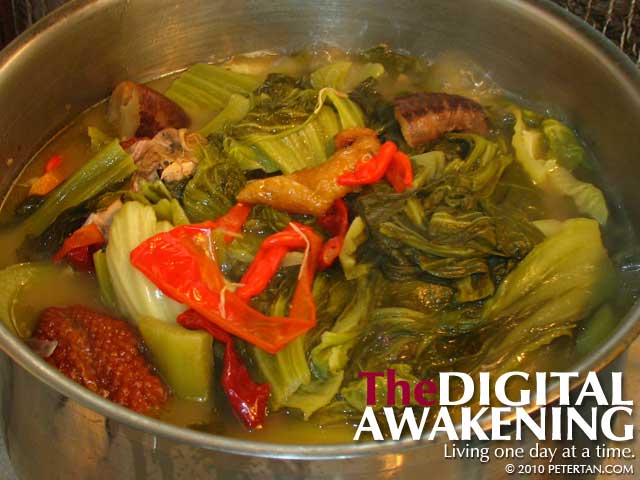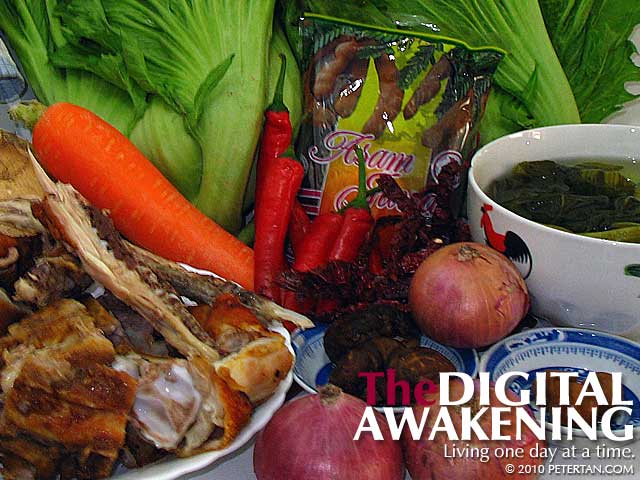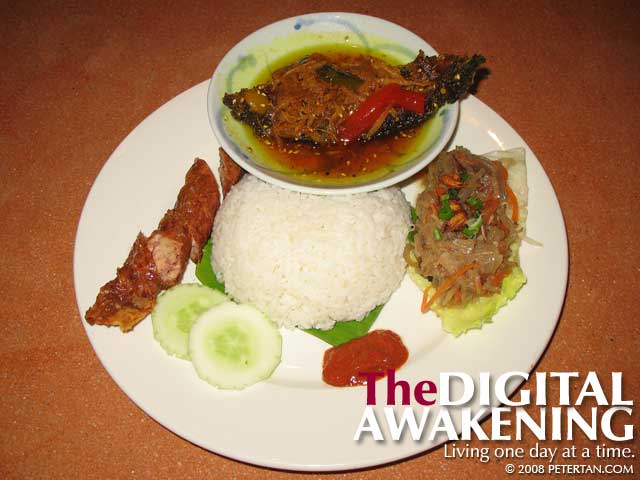The most appetising dish in Chinese cuisine can neither be found in the Imperial menus nor famous Chinese restaurants anywhere. Although the ingredients used may sound disgusting to some, it is those very ingredients that make the soup of this unique dish tasty. Chai boey, literally translated from the Chinese Hokkien dialect, means leftover food.
That is exactly what is used – food leftover from a feast, and stewed in a big pot the next day, or on the next weekend. The leftovers can be anything from abalone, scallops, roast pork, roast duck, lor bak (5 spice pork roll), lup cheong (waxed sausages) to chap chai (mixed vegetable dish). When Dad was around, we usually celebrated his birthdays with scrumptious steamboat dinners. The remaining soupbase after the dinner would be used together with whatever else that was still available like fish maw, quail eggs, Shiitake and button mushrooms, baby corns and carrots to make chai boey.
Apart from the leftovers, roast pig trotter, kiam chai (salted vegetables) are usually added to make the soup even tastier. Kua chai (Chinese mustard, gai choy) is a must have. The cooking of this dish is sometimes held back until the availability of this important ingredient. Asam jawa (tamarind) juice, pickled plums, dried chillies and pepper corns were added to the pot to enhance the flavour of the stew. It is spicy, sourish and very tasty at the same time.
 Chai boey.
Chai boey.No two chai boey are the same. The recipe differs from one family to another. How they taste are very much dependent on the leftover food used. My favourite chai boey is usually during Cheng Beng (Tomb Sweeping Day) in April, Phor Tor (Hungry Ghosts Festival) during the Chinese seventh month and Koay Tang (Winter Solstice Festival) in December. There would be generous amount of roast pork, roast duck and best of all, jiu hu char. The stir-fried sengkuang (yam bean) made the soup extra delicious.
A few weeks back, Wuan gathered the main ingredients for chai boey. They included roast pig trotter, Chinese mustard, salted vegetables, pickled plums, tamarind, carrots, sengkuang, carrots, fresh red chillies, dried chillies, onions and Shiitake mushrooms, among others. Although it tasted nice, it did not have that chai boey character like those that I used to eat back in Penang. Chai boey without jiu hu char just does not taste the same. To illustrate the importance of jiu hu char, whenever Mum wanted to make chai boey in between festivals, she would cook jiu hu char a few days earlier for one of the meals. The leftover is then used for chai boey.
In the Klang Valley, this stew is called suen lat choi, sour and spicy vegetables in Cantonese, as the majority of the population speaks this Chinese dialect. It is also known as choi kiok which also means leftover food. The ingredients would be more or less like those that Wuan used. The cooking style is also the same although the leftover food may differ.
 Ingredients for chai boey.
Ingredients for chai boey.Basically, the recipe calls for the Chinese mustard (2 heads) to be thoroughly cleaned as a lot of soil is trapped between the leaves. It is then cut in quarters and kept aside. Water is added to 4 tablespoonful of tamarind pulp and the liquid sieved. This is poured into the pot together with 3 onions (quartered), 2 large carrots (cut into chunks), 1 medium size sengkuang (cut into large cubes), 2 portions of salted vegetables (cut into quarters), 4 pickled plums, 20 pepper corns (cracked with the side of chopping knife), a handful of dried chillies and 5 fresh red chillies cut lengthwise and the seeds removed. If the leftovers do not include Shiitake mushrooms, 10 can be soaked the night before, halved and added at the same time.
The leftovers are added together with roast chicken and duck parts, roast pig bones and roast pig trotter. The pig trotter should be chopped into large chunks. One can usually get the roast pork seller to do that. The pot is filled with water just sufficient to cover all the ingredients and brought to boil. The heat is then turned down to allow the stew to simmer for 1 hour. By then it should exude a mouthwatering aroma with a strong tangy aroma.
The Chinese mustard is added last to prevent it from being overcooked and becoming mushed. Water is added to cover the vegetable and allowed to simmer for another half hour until the Chinese mustard is thoroughly cooked and have soaked in the flavours of the stew. By then, the pig trotter should be very tender and the meat almost separating from the bones. If the soup is not sourish enough, tamarind juice or pickled plums can be added to taste. Chai boey can be served with rice or eaten as is.
Whether it is called chai boey or suen lat choi, I would be contented with just chai boey and rice for lunch and dinner on any given day. I would add a few ladles of the soup to my rice followed by generous portions of Chinese mustard, Shiitake and button mushrooms and roast pork. Those I would dip in soy sauce. No words can describe the pleasure as I slowly masticate the pork and the Chinese mustard and allow the flavours to titillate my olfactory senses. The chai boey is truly a piece of culinary heaven. No one can claim to have savoured the best tasting food in the world if they have not eaten this dish before.

